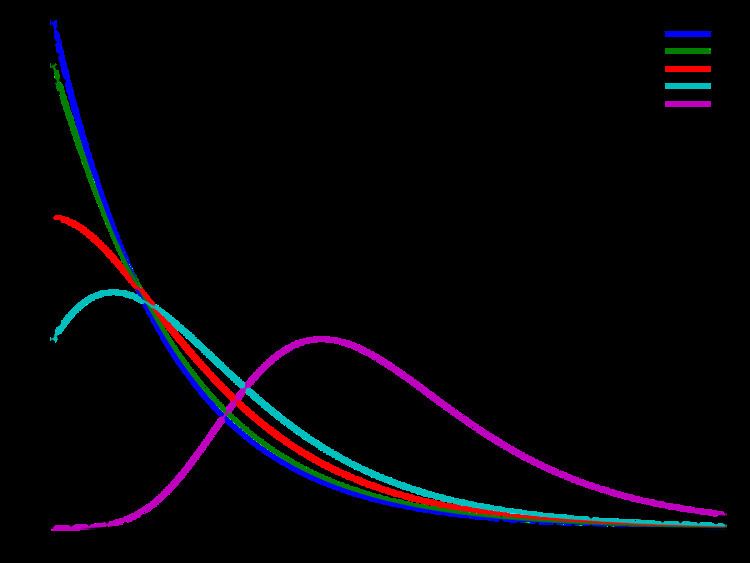 | ||
Parameters Support x ∈ [ 0 , ∞ ) {\displaystyle x\in [0,\infty )\!} PDF b e − b x e − η e − b x [ 1 + η ( 1 − e − b x ) ] {\displaystyle be^{-bx}e^{-\eta e^{-bx}}\left[1+\eta \left(1-e^{-bx}\right)\right]} CDF ( 1 − e − b x ) e − η e − b x {\displaystyle \left(1-e^{-bx}\right)e^{-\eta e^{-bx}}} Mean ( − 1 / b ) { E [ ln ( X ) ] − ln ( η ) } {\displaystyle (-1/b)\{\mathrm {E} [\ln(X)]-\ln(\eta )\}\,} where X = η e − b x {\displaystyle X=\eta e^{-bx}\,} and E [ ln ( X ) ] = [ 1 + 1 / η ] ∫ 0 η e − X [ ln ( X ) ] d X − 1 / η ∫ 0 η X e − X [ ln ( X ) ] d X {\displaystyle {\begin{aligned}\mathrm {E} [\ln(X)]=&[1{+}1/\eta ]\!\!\int _{0}^{\eta }\!\!\!\!e^{-X}[\ln(X)]dX\\&-1/\eta \!\!\int _{0}^{\eta }\!\!\!\!Xe^{-X}[\ln(X)]dX\end{aligned}}} Mode 0 for 0 < η ≤ 0.5 {\displaystyle 0{\text{ for }}0<\eta \leq 0.5} ( − 1 / b ) ln ( z ⋆ ) , for η > 0.5 {\displaystyle (-1/b)\ln(z^{\star }){\text{, for }}\eta >0.5} where z ⋆ = [ 3 + η − ( η 2 + 2 η + 5 ) 1 / 2 ] / ( 2 η ) {\displaystyle {\text{ where }}z^{\star }=[3+\eta -(\eta ^{2}+2\eta +5)^{1/2}]/(2\eta )} | ||
The shifted Gompertz distribution is the distribution of the largest of two independent random variables one of which has an exponential distribution with parameter
Contents
- Probability density function
- Cumulative distribution function
- Properties
- Shapes
- Related distributions
- References
It has been used to predict the growth and decline of social networks and on-line services and shown to be superior to the Bass model and Weibull distribution (Bauckhage and Kersting 2014).
Probability density function
The probability density function of the shifted Gompertz distribution is:
where
The distribution can be reparametrized according to the innovation-imitation paradigm with
When
Cumulative distribution function
The cumulative distribution function of the shifted Gompertz distribution is:
Equivalently,
Properties
The shifted Gompertz distribution is right-skewed for all values of
Shapes
The shifted Gompertz density function can take on different shapes depending on the values of the shape parameter
Related distributions
When
with:
One can compare the parameters
